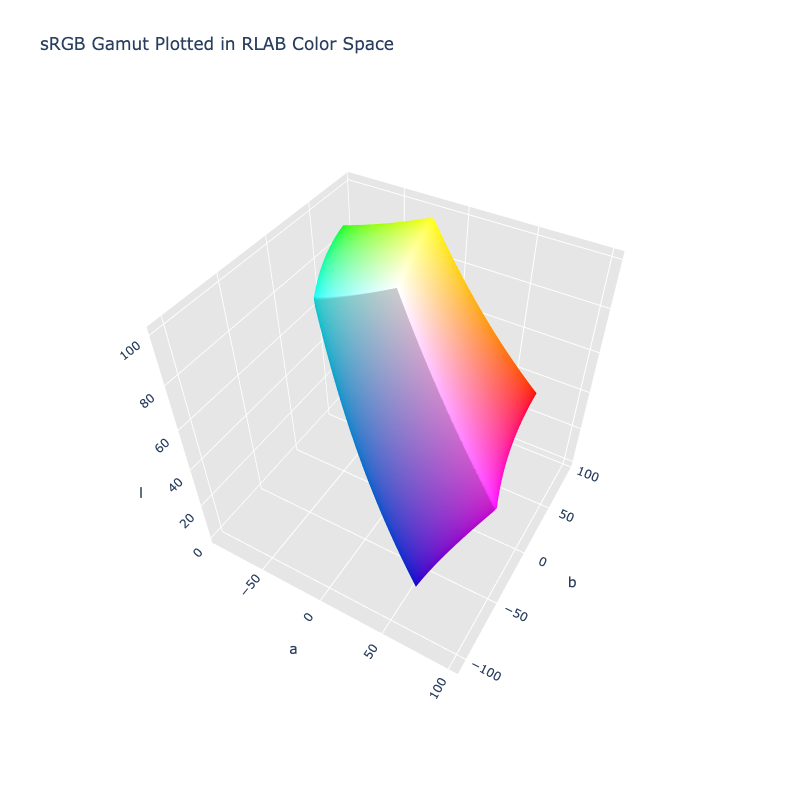RLAB
The RLAB color space is not registered in Color by default
Properties
Name: rlab
White Point: D65 / 2˚
Coordinates:
| Name | Range |
|---|---|
l | [0, 100] |
a | [-125, 125] |
b | [-125, 125] |
* Space is not bound to the range and is only used as a reference to define percentage inputs/outputs in relation to the Display P3 color space.

The sRGB gamut represented within the RLAB color space.
The RLAB color-appearance space was developed by Fairchild and Berns for cross-media color reproduction applications in which images are reproduced with differing white points, luminance levels, and/or surrounds.
ColorAide provides RLAB by default with average surround, and discounting set to "hard copy" (or full discounting of the illuminant). It is also configured to use an absolute adapting luminance of 318 cd/m2.
Viewing Conditions
RLAB can be configured with different viewing environments. An RLAB color space will also have an associated environment object. This environment object determines the viewing conditions. Colors will appear different based on the viewing conditions.
| Viewing Conditions | Description |
|---|---|
white | This is the white point and should be the same as defined in the color class. This is provided as (x, y) chromaticity coordinates. |
adapting_luminance | The luminance of the adapting field (often known as La). The units are in cd/m2. |
surround | A description of the peripheral area. Use "dark" for a movie theater, "dim" for e.g. viewing a bright television in a dimly lit room, or "average" for surface colors. |
discounting | Degree of discounting of the illuminant. A string of either "hard-copy", "projected-transparency", or "soft-copy". Hard copy indicates full discount, or the eye is assumed to be fully adapted to the illuminant. Projected transparency performs 50% discount. |
ColorAide must provide some defaults, so the RLAB space has a default set of viewing conditions that uses a D65 white point, an adapting luminance of 1000 lux or a value of ~318.31 cd/m2, an "average" surround, and sets discounting to "hard-copy". These are the same settings that were demonstrated in the original paper.
These settings do not have to be used, and a new RLAB variant with different viewing conditions can be created. When doing this, the space should be derived from the default RLAB space.
>>> from coloraide import Color as Base
>>> from coloraide.spaces.rlab import RLAB, Environment
>>> from coloraide.cat import WHITES
>>> from coloraide import util
>>> import math
>>> class CustomRLAB(RLAB):
... NAME = "rlab-custom"
... SERIALIZE = ("--rlab-custom",)
... WHITE = WHITES['2deg']['D65']
... ENV = Environment(
... white=WHITE,
... adapting_luminance=64 / math.pi * 0.2,
... surround='average',
... discounting="soft-copy"
... )
...
>>> class Color(Base): ...
...
>>> Color.register([RLAB(), CustomRLAB()])
>>> Color('white').convert('rlab')
color(--rlab 100 0 0 / 1)
>>> Color('white').convert('rlab-custom')
color(--rlab-custom 99.387 -5.2351 -3.5078 / 1)
Note
If a discounting of anything other than "hard-copy" is used, you will notice the achromatic response to cause colors like white to not have value of zero chroma. This is because the eye is not fully adapted, and colors appear different with this context. This is not a bug, just the way viewing conditions can affect model.
Channel Aliases
| Channels | Aliases |
|---|---|
l | lightness |
a | |
b |
Input/Output
The RLAB space is not currently supported in the CSS spec, the parsed input and string output formats use the color() function format using the custom name --rlab:
color(--rlab l a b / a) // Color function
The string representation of the color object and the default string output use the color(--rlab l a b / a) form.
>>> Color("rlab", [51.012, 79.742, 57.26])
color(--rlab 51.012 79.742 57.26 / 1)
>>> Color("rlab", [72.793, 25.151, 74.11]).to_string()
'color(--rlab 72.793 25.151 74.11)'
Registering
from coloraide import Color as Base
from coloraide.spaces.rlab import RLAB
class Color(Base): ...
Color.register(RLAB())